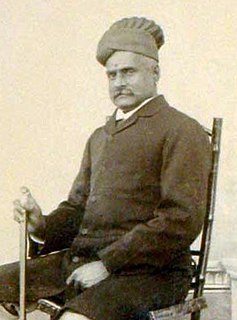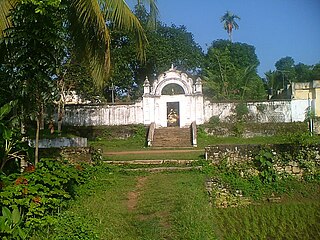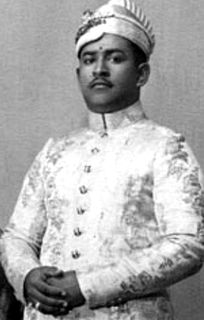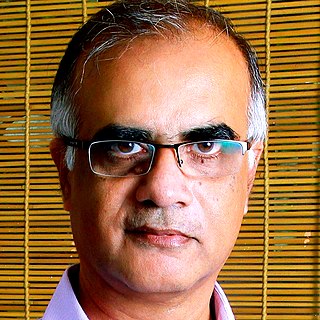
Raja Ravi Varma was an Indian painter and artist. He is considered among the greatest painters in the history of Indian art. His works are one of the best examples of the fusion of European academic art with a purely Indian sensibility and iconography. Specially, he was notable for making affordable lithographs of his paintings available to the public, which greatly enhanced his reach and influence as a painter and public figure. His lithographs increased the involvement of common people with fine arts and defined artistic tastes among common people. Furthermore, his religious depictions of Hindu deities and works from Indian epic poetry and Puranas have received profound acclaim. He was part of the royal family of erstwhile Parappanad, Malappuram district.

Anizham Thirunal Marthanda Varma, known as the "Maker of Modern Travancore", was ruler of the Indian kingdom of Travancore from 1729 until his death in 1758. He was succeeded by Rama Varma (1758–98).
Valiathan, alternatively Vallyathan, is a title, and now family name, held by a group of Nair families, all branches along the matrilineal line of the main Valiathan family, who are known as the Vattaparambil Valiathan. According to legend, it is said that the Maharajah Marthanda Varma of Travancore sought the help of the Vattaparambil, later Valiathan, family in order to overcome the powerful clan of Ettuveetil Pillamar, the Lords of the Eight Houses. The Maharajah and his heir apparent, the popular Dharmarajah, therefore addressed the oldest, and most powerful, lady of the Vattaparambil House as Valiyamma. Later the lord of the Vattaparambil House died in battle against the Ettuveetil Pillamar, leaving the family without a head figure. When Marthanda Varma finally became king, he gave the title of "Valiathan" to the Vattaparambil family.

Kilimanoor is a panchayat and a town in the Chirayinkeezhu taluk of Trivandrum district in Kerala, India. It is located on MC/SH 1 Road, 33 kilometres (21 mi) North-west of the city of Thiruvananthapuram (Trivandrum), 14 km east of Attingal and 20 km (12 mi) east of Varkala. The town area is administrated by Pazhayakunnummel Gramapanchayath. The town areas of kilimanoor town comes within pazhayakunnummel grama panchayath but there is also a panchayath called kilimanoor panchayath which lies west to pazhayakunnummel panchayath.Kilimanoor is the first main town in the Thiruvananthapuram district when one travells from north kerala to capital district Via Main Central Road(M.C.Road)Kilimanoor town is an important business centre and one of the potential fast-growing towns in south Kerala. Kilimanoor is looking forward to become a municipality.

Kilimanoor Palace is a palace located in Kilimanoor, in the Indian state of Kerala. It is the birthplace of painter Raja Ravi Varma and Raghava Varma, the father of king Marthanda Varma.
Marthanda may refer to one of the following persons.

Vattakottai Fort is a seaside fort near Kanyakumari, Tamil Nadu the southern tip of India. It was built in the 18th century as a coastal defence-fortification and barracks in the erstwhile Travancore kingdom.

Ramayyan was the Dewan of Travancore state, India, during 1737 and 1756 and was responsible for the consolidation and expansion of that kingdom after the defeat of the Dutch at the 1741 Battle of Colachel during the reign of Maharajah Marthanda Varma, the creator of modern Travancore.
Rajah Rama Varma was the ruler of the Indian kingdom of Venad, later known as Travancore, in the modern day state of Kerala, India between 1724 and 1729, having succeeded his brother Unni Kerala Varma. He is better known as the uncle of Maharajah Padmanabha Dasa Vanchi Pala Marthanda Varma Kulasekhara Perumal, the "maker of modern Travancore". He was born into the Royal Family of Kolathunadu, as the second son of Rajah Ittamar of Thattari Kovilakam. It was princes from the Parappanadu family who customarily married Kolathunadu princesses. Rama Varma's entire family, including himself, two sisters and his elder brother Unni Kerala Varma, were adopted into the Venad house as members of the Travancore Royal Family by Rajah Ravi Varma, nephew of Umayamma Rani due to the failure of heirs there. Ittammar Raja's sister and her sons, Rama Varma and Raghava Varma, settled in Kilimanoor and married the now adopted sisters. Of the adopted sisters, one died soon after her adoption while the other was the mother of the Maharajah Marthanda Varma.

Sree Padmanabhadasa Sree Uthradom Thirunal Marthanda Varma was the titular Maharaja of Travancore. He was the younger brother of the last ruling monarch of the Kingdom of Travancore, Maharajah Chithira Thirunal Balarama Varma.

The Travancore royal family was the ruling house of the Kingdom of Travancore. They give up their ruling rights in 1949 when Travancore merged with India and their remaining privileges were abolished in 1971. The family are descended from the Ay/Venad family, Cheras, Pandyas and Cholas. The ruler in that bloodline was Maharaja Sree Moolam Thirunal, as the family of Maharaja Chithira Thirunal and successors.

Marthanda Varma is a 1933 black and white Indian silent film directed by P. V. Rao, based on the 1891 Malayalam novel by C. V. Raman Pillai. This was the first film based on Malayalam literature and the next film of the Malayalam film industry after Vigathakumaran.

Marthandavarma is a historical romance novel by C. V. Raman Pillai published in 1891. It recounts the history of Venad (Travancore) during the final period of Rajah Rama Varma’s reign and subsequently to the accession of Marthanda Varma. Set in Kollavarsham 901–906, the story revolves around three protagonists, Ananthapadmanabhan, Subhadra and Mangoikkal Kuruppu, who try to protect the title character from Padmanabhan Thambi and Ettu Veetil Pillamar who plan to oust him from the throne of Travancore. The novel utilizes rich allusions to the Indian subcontinent and Western, historical, cultural and literary traditions.
Chirayinkeezhu Taluk is a Taluk (tehsil) in Thiruvananthapuram district in the Indian state of Kerala. It is shares border with Varkala Taluk in North and with Thiruvananthapuram Taluk in South. It comprises 12 panchayats and Attingal Municipality. Chirayinkeezhu taluk is the birthplace of a host of illustrious personalities like the painter Raja Ravi Varma, the great poet and social reformer Kumaran Asan and Prem Nazir etc.
Ravivarma Marthanda Varma was an Indian neurosurgeon, one of the pioneers of Indian neurosurgery and the founder director of the National Institute of Mental Health and Neurosciences (NIMHANS). He was the originator of a new surgical procedure for treating Parkinson's disease which later came to be known as Varma's Technique. He was a former Deputy Director General of Health Services, Government of India and an honorary surgeon to R. Venkataraman, former president of India. He was honoured by the Government of India in 1972 with Padma Shri, the fourth highest Indian civilian award.

Sreekumar Krishnan Nair is an Indian filmmaker, best known for directing the 1993 film O' Faby, which was India's first full-length live action/animation hybrid feature film. He is the youngest son of prolific south Indian filmmaker M. Krishnan Nair and younger brother of Retired Indian Administrative Service officer, poet and lyricist K. Jayakumar.

P.V. Rao, also known as V.V. Rao was an Indian film director and actor of the 1930s and 1940s. He directed the first movie which based on a historical literature written by C. V. Raman Pillai and the movie was Marthanda Varma. Marthanda Varma is also the second silent black and white movie in Malayalam and its script was also written by P.V. Rao.











